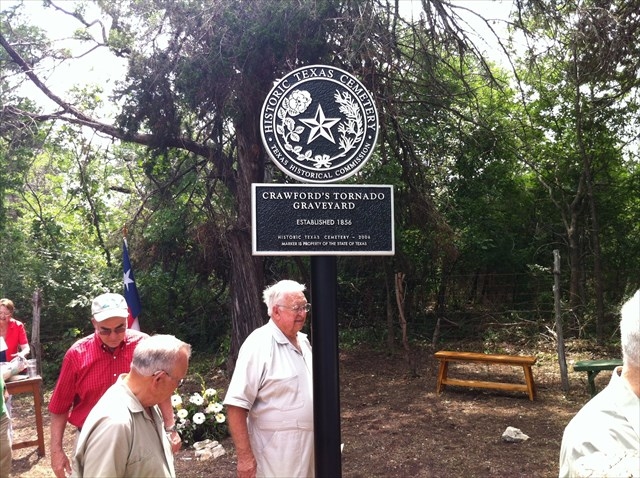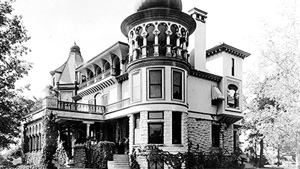By Frances James (1922 – 2019)
The Crawford Cemetery has an address of 700 Cedar Hill in Cedar Hill, Texas. This site is in the southwest corner of Dallas County. Ever since histories have been written about Dallas County mention has been made of “the tornado that wiped out the village of Cedar Hill in 1856.” The death toll was mentioned and logic tells us there was a cemetery- but where? Many whose ancestors had lived in the vicinity had heard about the church and the cemetery but only a few had seen the cemetery. One snapshot from fifty years ago was found, but that was not a location! Contemporary lore was that the land was owned by some doctors who had posted “No Trespassing” signs denying access to the property.
The following story of the cemetery and the documented history of the land, the victims, and the families is because one devoted person, Wanda Pitt, a member of the Cedar Hill Historical Society took time from her busy life to research this site and sort out the facts from the lore. I am now, with her approval, proudly using her research to “spread the word” about the Crawford Cemetery in this book.
After the War with Mexico was over in 1836 settlers started coming to the Republic of Texas through Indian Territory, or across the border from Arkansas or Louisiana. Robert Crawford (1815-1888) a native of South Carolina was a Methodist minister and teacher when he came to Texas in the 1840s. He was elected secretary of the East Texas Methodist Conference in Marshall, Texas in 1845. He went to the next county, also on the border with Louisiana, to find and marry New York native Mary C. Gray in Panola County, Texas in 1846. From there they moved in 1850 with a two year old son to Cass County where he served as a minister.
Dallas County Deed records show that in 1852 Robert Crawford purchased for $500.00 the 320 acre Zur Combs Survey. Peters Colonist Combs came to Texas as a single man prior to 1848. By the time of the 1850 census he is listed as a twenty-two year old farmer from Ohio with a wife, Missouri native Sarah Evans, twenty-one years old – family No. 350. There is reason to believe the Combs family may have gone to Ellis County after they sold their grant, but that would be a separate research project.
Methodist ministers are part of an itinerant covenant, they are traveling preachers. The bishop in each Conference APPOINTS Methodist pastors and SENDS them to serve where needed or where they have been CALLED by a congregation. In the 1912 book written by W.H. Hughes a Dallas Methodist preacher who helped organize many of the early Methodist churches, mention is made of the first churches organized in Dallas County before 1850. Hughes states that the Methodist Church in Cedar Hill was established soon after that date. He reports that the early pastors at Cedar Hill were the Reverends Hemy W. South, J. M. Wright, Robert “Crofford” and I.P. Jeffers. Since the Methodist church operated under certain rules, met annually and each church made reports, some documentation has been available. The history of the Cedar Mountain Methodist Church lists Robert Crawford as one of the seven trustees in 1854. The report to the Texas Methodist Conference for this year revealed that the church in Cedar Hill has 150 white members, no colored, and has two preachers.
Even though settlers were promised head right grants by Peters Colony agents the settlers were unable to secure the land until l852. Many of them promised or assigned their head right grants to others. Ellis C. Thomas, native of Tennessee, came to the colony as a single man prior to 1844. He reported to the Colony agent that he had married before 1848 and was issued a certificate for 640 acres. He patented this in two separate places; one in Dallas County and one section for 320 acres was in Robertson County. This land soon became part of Dallas County too. This is the land the Cedar Mountain Church was built on. The patent for the land was signed by Governor E.M. Pease on June 19, 1854.
Ellis C. Thomas transferred the deed for the 320 acres to Milton Merrifield on August 7, 1854. Two months later (October 5, 1854) Milton and Margaret Ann Merrifield sold 2 1/2 acres to the Trustees of the Cedar Mountain Church for $22.50. This deed also allowed the church to access the water from the nearby spring. The Trustees at that time were Samuel Harrison, Robert Crawford, John Bell, Samuel F. Newby, Joseph Bell, William Bradford, and J.M. Standifer. The church was built on the land before this deed was signed. Robert preached and taught school at the church which was south of the Combs Survey. Mary Gray Crawford is listed as an assistant teacher.
Milton was one of four Merrifield brothers to come to Texas in 1849. He had married Margaret Ann Singleton in Kentucky. They eventually had nine children. Their homestead was on the Ellis C. Thomas Survey where the church was built near the section line between the 320 acre Zur Combs Survey, Robert Crawford’s land, and the Ellis C. Thomas survey.
Cedar Hill is the highest point in Dallas County and is west of the Trinity River. It would have been in Robertson County before Dallas County was formed in 1845. On April 29, 1856 a tornado struck Cedar Hill and destroyed the village killing at least nine people. Through the years there has been some discussion as to whether there were nine or eleven people killed. Due to the scarcity of documentation we shall never know. Only two structures in the village remained, all others were swept away, nothing left but evidence of some of the foundations. The church was demolished. The article that appeared in the Dallas Herald a few days later reporting on the tornado, graphically described the condition of the bodies when found. Families that lost members were devastated as they searched for loved ones. There were reports of items found in other sections of the county twenty-five or thirty miles away days later.
Without the knowledge or chemicals necessary for embalming, the bodies of all of the victims of the tornado were buried quickly near the church, on land Robert Crawford offered for a burial place. This cemetery is located on the Zur Combs Survey No. 306.
John Hart, his wife and child were buried here. Others, probably in the same family, were William C. Hart who was severely injured, Thomas Hart and wife slightly injured, and Henderson Hart who was with Mr. John Berry at the store where Berry was killed. Henderson had a skull fracture and was “dangerously” injured the paper said.
Another victim was Mr. John Berry, who was said to have had a house and store that was demolished. A sturdy trunk bound with iron bands belonging to him with papers and money was found torn to pieces. Scraps of items were littered in every direction. Berry had a wife and child – all three are buried in the cemetery. The article in the Dallas Herald said that Berry was a partner with Madison. M. Miller who had a store on Pleasant Run in Lancaster. Mr. Miller was on his way to Cedar Hill when the tornado formed and wiped out his store and the town.
Daddy Dixon/Dickson was making a delivery to John Berry’s store. Another resource said he was a clerk in the store. The newspaper article said Dickson saw the storm coming, tried to outrun it, and ended up clinging to a pole. He was buried here.
Martha Allen, wife of Jacob Allen and mother of two children was reported killed. She is buried here.
An unnamed Negro woman was reported killed. It has not been determined who she belonged to, if a slave. She was in Mr. Berry’s store when it was destroyed. She, too, was buried here.
The newspaper article also listed those injured. James Donaldson and William Spence were both severely injured. Jacob Allen and his two children were slightly injured as were A. White and Mr. Hartman.
When the tornado struck Cedar Hill it demolished the church and the Merrifield’s house. Baby Maggie Merrifield was lying in her cradle. The storm blew the cradle with baby in it out into the yard into a large rose bush! This held the cradle and protected the baby. Maggie’s granddaughter has a rose cut from the bush preserved and a cutting from the bush still thriving in her yard! At the time of the storm another small child, Susie, was on a feather bed and was not harmed either.
The remote area has no sign of graves. No headstones were ever placed for those buried here. At some time in the past a fence was erected to enclose the small plot. In three comers are very large, extremely tall cedar trees. These tall trees are one of the ways to find the site! The fence encloses the trees inside the plot. The fourth comer has a tree, of unknown variety. The Trinity River Authority has cleared a Right of Way and there are signs of warning not to dig as this is a sewer line through here.
During Wanda Pitt’s tedious research through what records were available for the time period she found county deed records posted incorrectly, wrong Volume numbers used, wrong page numbers posted, names misspelled. She diligently kept fitting the information together and it has now been forwarded to Dallas County Appraisal District, the Texas Historical Commission and the General Land Office Records in Austin. The cemetery has been added to Dallas County records as an unknown or abandoned cemetery.
Wanda followed up with her research through the 1860 and 1870 census attempting to find any more information on who some of the people were or where they may have gone. The still vacant land surrounding the cemetery and site of the church may be developed in the near future since it has recently changed hands. The sites will be protected by Federal and State Law.
James, Frances, “Dallas County History – From the Ground Up, Vol. III,” 2011.
Marc Moore’s photos from the 2012 cemetery dedication:







